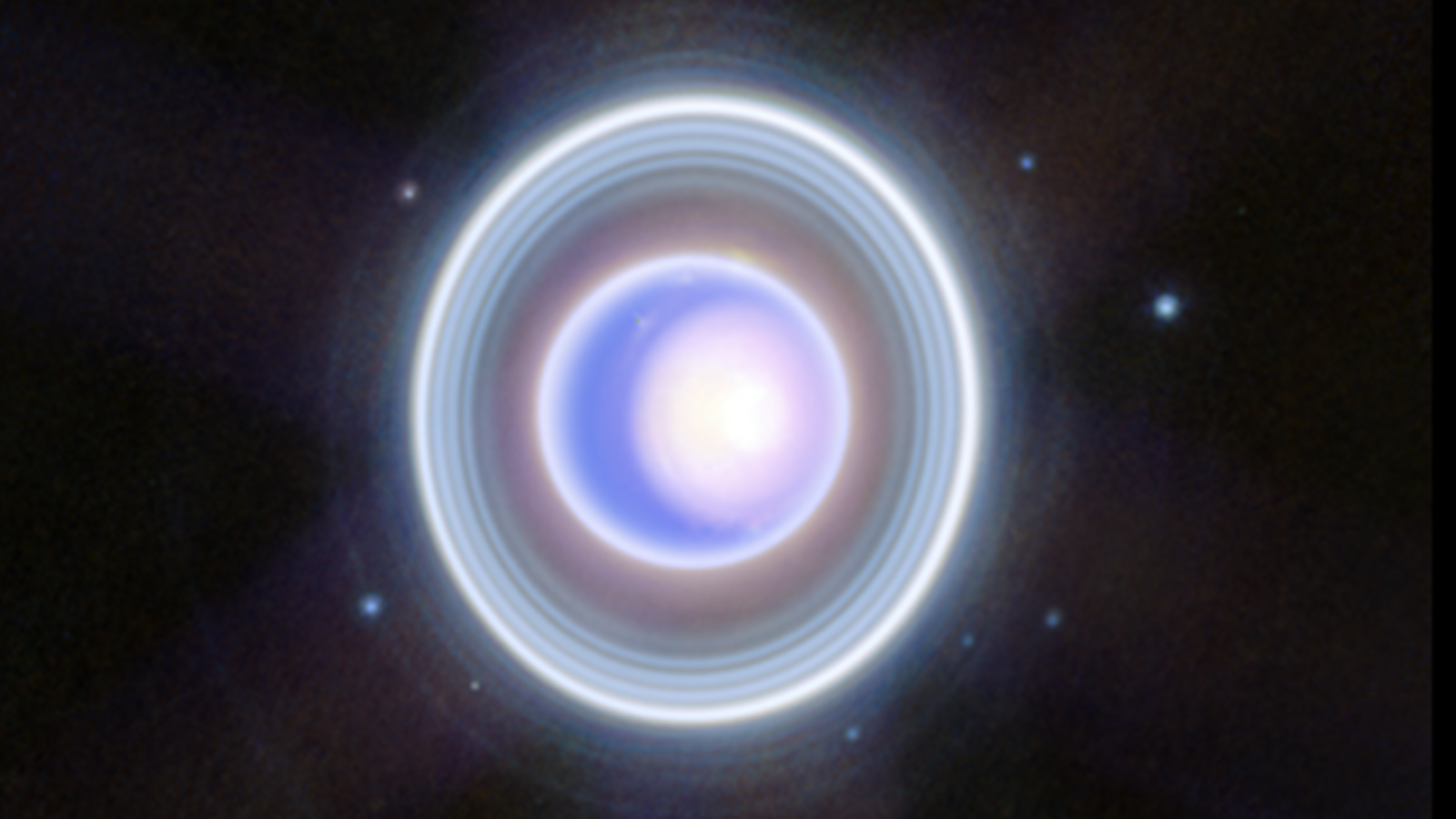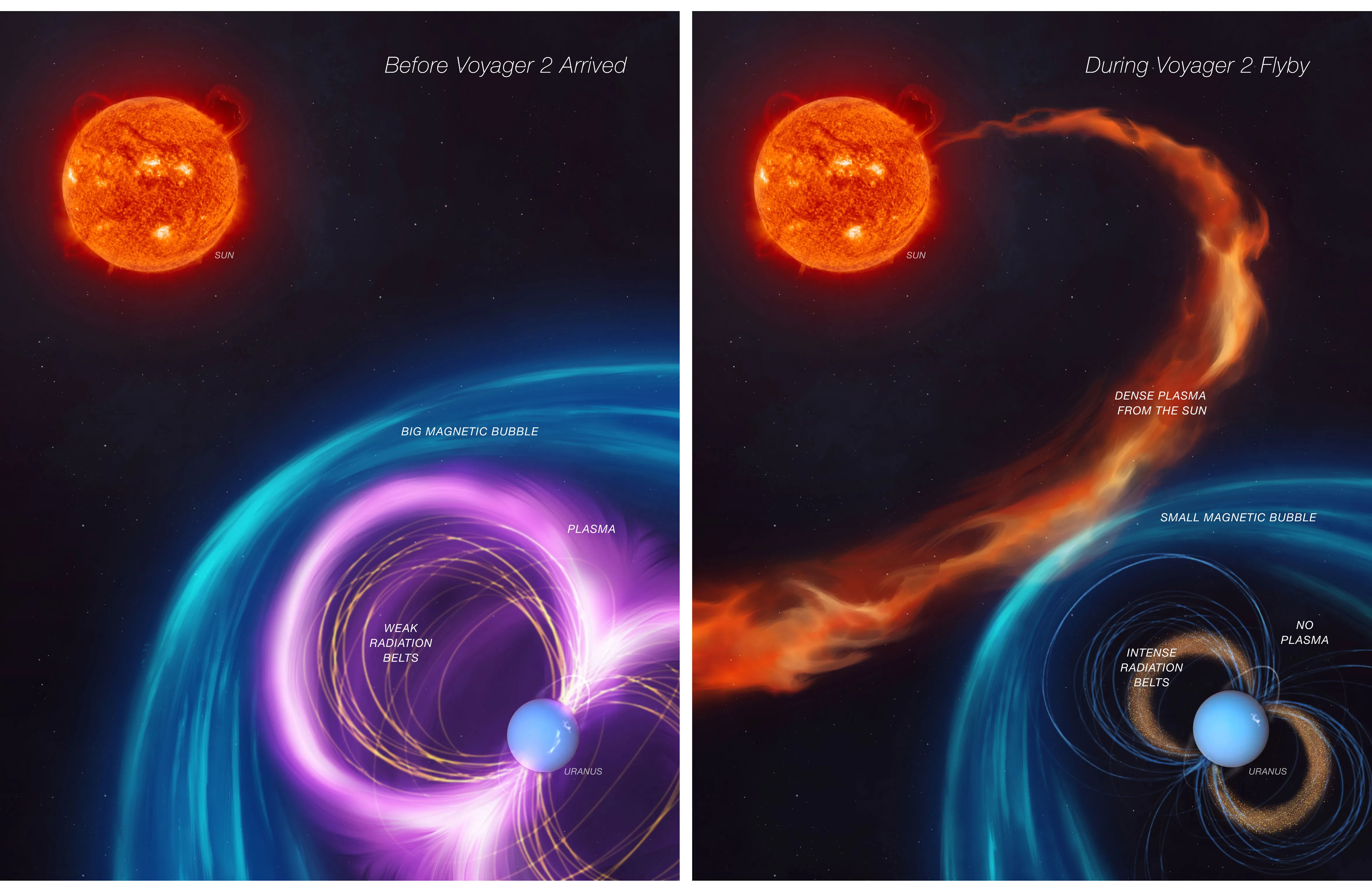Long ago, Voyager 2 might have caught Uranus at a bad time
"The spacecraft saw Uranus in conditions that only occur about 4% of the time."

Much of what we understand about Uranus comes from data gathered by NASA's Voyager 2 spacecraft. Thirty-eight years ago, this probe flew by the ice giant, providing humanity with its first close-up glimpse of the seventh planet from the sun.
However, the snapshot delivered by Voyager 2 gave us a peculiar picture of Uranus. It suggested the world has an extreme magnetosphere — at risk of simplification, a giant magnetic field around the planet — that's filled with energized particles swirling around. And, well, this just didn't jibe with scientists' knowledge of the way magnetic fields work. The problem was an observed lack of plasma in Uranus's magnetosphere, which is an expected prerequisite for the energized particles Voyager 2 saw there.
Ever since, Uranus has been viewed as an outlier — called the planet with a weird magnetosphere. But a new analysis of that original 1986 data may finally offer Uranus some reprieve. It's possible, scientists say, that something altered Uranus's magnetosphere long ago — right when Voyager 2 flew by.
That something, the research team says, was a surge in solar wind pressure, or a high uptick in charged particles (or plasma) released from the sun’s outer layer, the corona. The pressure could have drastically altered Uranus's magnetosphere, compressing it to about 20% of what it normally would be. That pressure could also lead to plasma within the magnetosphere emptying out temporarily.
Related: Some of Uranus's moons might be able to support life. Here's what a mission might reveal
So, in other words, our understanding of Uranus for the last few decades may have been highly skewed simply due to the unfortunate timing of Voyager 2's flyby.
"The spacecraft saw Uranus in conditions that only occur about 4% of the time," Jamie Jasinski, lead author of the new analysis and a space plasma physicist at NASA's Jet Propulsion Laboratory (JPL), said in a statement. “If Voyager 2 had arrived just a few days earlier, it would have observed a completely different magnetosphere at Uranus."
Breaking space news, the latest updates on rocket launches, skywatching events and more!
What is a magnetosphere?
A magnetosphere is a "bubble" around a planet that plays a big role in the planet's conditions by shielding it from both cosmic and solar particle radiation. Such particle radiation gets trapped along the magnetosphere’s magnetic field lines, which concentrate the trapped particles into radiation belts. Earth's magnetosphere, for instance, protects our atmosphere from solar winds that emanate from the sun. Without it, our atmosphere would deteriorate, which would make Earth uninhabitable.
Uranus's observed magnetosphere was puzzling for scientists because of how extremely intense its radiation belts appeared to be. They had an "intensity second only to Jupiter's notoriously brutal radiation belts," according to the statement. Yet there was no recognizable source of energized particles, so those intense radiation belts remained a mystery — until now.
When factoring in the solar wind surge theory, the picture starts making sense.
Solar wind pressure likely drove out plasma from Uranus's magnetosphere system and created a temporary condition in which the planet's magnetosphere became quite extreme. The wind would've injected charged particles (recall it's made of plasma) into Uranus's radiation belts, potentially accounting for their surprising intensity.
As a side note, the new analysis also suggests Uranus's five major moons, which were previously thought to be inert, may in fact be geologically active.

"We were searching for an explanation of its unusual behavior," JPL scientist Linda Spilker, who remembers when Voyager 2 flew by Uranus in 1986, said in the statement. "This new work explains some of the apparent contradictions, and it will change our view of Uranus once again," continued Spilker.
ASA launched Voyager 2 aboard the Titan IIIE-Centaur way back in 1977. It was the first of two probes designed to examine the outer planets. Voyager 1,essentially its twin, launched a few weeks later.
Now, Voyager 2 is nearly 13 billion miles away from Earth, and NASA is still in contact with it, receiving valuable scientific data on our solar system and beyond. A few weeks ago, NASA made the difficult decision to turn off one of Voyager 2's science instruments to conserve power so it could continue its mission.
The beloved Voyager 1 has also nabbed plenty of headlines in the last couple of months. Last year, Voyager 1 put scientists and space lovers across the world on the edge of their seats, as NASA lost contact with the venerable space explorer, only to regain it a few months later due to the intrepid work of its operators.
The research was published in the journal Nature Astronomy on Nov. 11.
Join our Space Forums to keep talking space on the latest missions, night sky and more! And if you have a news tip, correction or comment, let us know at: community@space.com.

Julian Dossett is a freelance writer living in Santa Fe, New Mexico. He primarily covers the rocket industry and space exploration and, in addition to science writing, contributes travel stories to New Mexico Magazine. In 2022 and 2024, his travel writing earned IRMA Awards. Previously, he worked as a staff writer at CNET. He graduated from Texas State University in San Marcos in 2011 with a B.A. in philosophy. He owns a large collection of sci-fi pulp magazines from the 1960s.
